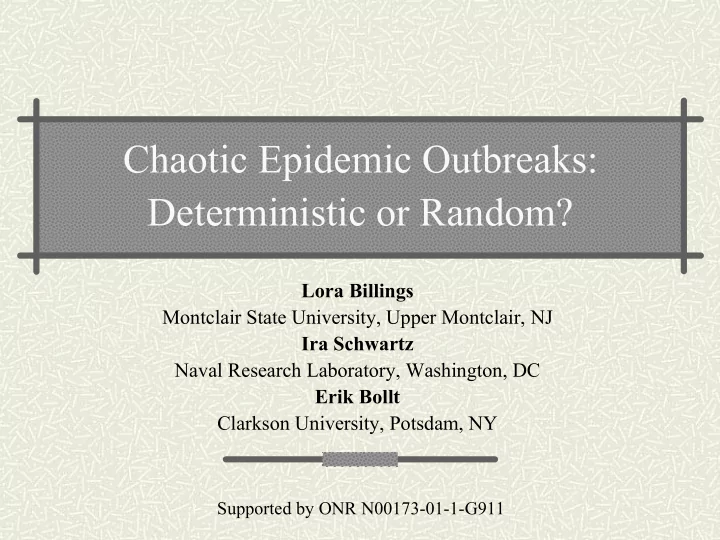

Chaotic Epidemic Outbreaks: Deterministic or Random? Lora Billings Montclair State University, Upper Montclair, NJ Ira Schwartz Naval Research Laboratory, Washington, DC Erik Bollt Clarkson University, Potsdam, NY Supported by ONR N00173-01-1-G911
Measles Total number of U.S. cases Vaccine developed in 1963. http://science-education.nih.gov Graph by Alun Lloyd (2002)
Why do so many people study measles? The biological system is fairly simple � We can test and improve models (design vaccination strategies) � These models can be used for many applications (other diseases, computer viruses, etc.) Excellent data is available � We can ask detailed questions about spatial and temporal dynamics � The data exhibits periodic or more complex behavior Some have conjectured that the dynamics could be chaotic
D. Earn, et al. Science, 2000 Question: Is the pre-vaccine time series chaotic? Answer: Undetermined (Not enough data)
Outline SEIR model - a model for epidemics in childhood diseases (Yorke and London (1973); May and Anderson (1979); Schwartz (1983); Grenfell et al. (2000); Hethcote (2000)) Add stochastic perturbations to represent noise in population size Bifurcation to stochastic chaos Possible vaccination strategies to control and prevent future outbreaks
Modeling Epidemics: Assumptions The population: Assume the population is large and well mixed. Variables and parameters: S: Susceptibles α α α − α − − −1 1 1 : 1 : : : mean latent exposed period E: Exposed γ γ γ γ − − − −1 1 : 1 1 : : : mean infectious period I: Infectives µ: µ: µ: µ: birth and death rate β: β: R: Recovered β: β: contact rate (for S & I) Normalize the population: S + E + I + R = 1
The standard SEIR model dS = µ − β ( t ) IS - µ S µ µ µ µ dt dE = β ( t ) IS - α E - µ E γ γ γ γ β β β I β α α α α dt S E I R dI = α E - γ I - µ I dt µ µ µ µ µ µ µ µ µ µ µ µ µ µ µ µ dR = γ I - µ R dt
Our flavor = + = + The contact rate: β ( t ) β ( t 1 ) β ( 1 δ cos 2 π t ) 0 The infectives are roughly proportional to the exposed [Schwartz, J. Math. Biol. 1985] α ≈ I ( t ) E ( t ) + µ γ
The model we study The modified SI model (MSI) dS = − µ β ( t ) IS - µ S dt dI α = + β ( t ) IS - (µ α ) I + dt µ γ = + β ( ) β (1 δ cos(2 π )) t t 0 The paremeter we vary is δ
Bifurcation diagram The system is driven periodically, so consider the discrete map on the Poincare section.
Adding noise The system is driven periodically, so add noise as if it is a map. (Additive noise) Noise: normal distribution, mean=0, vary the standard deviation ( σ )
σ σ =0.01 σ σ σ =0.05 σ σ σ log(S) log(I) Noisy dynamics Time series time time Phase space log(I) log(I) diagram log(S) log(S) Probability density log(I) log(I) function log(S) log(S)
Stochastic Chaos? Deterministic definition (numerical) � Compact set � Positive Lyapunov exponent � Not asymptotically periodic Stochastic version? � Compact set � Positive Lyapunov exponent � Homoclinic/heteroclinic topology (makes chaotic orbits possible)
Lyapunov exponents Red: σ = 0.01 (noisy) Blue: σ = 0.05 (chaotic) log(I) log(S) But Lyapunov exponents can yield false results
Unstable manifolds Random trajectories follow the unstable manifolds of the period three saddle log(I) What is the role of the manifolds? log(S)
Smale Horseshoe Topology Homoclinic Orbit Heteroclinic orbit
Stochastic Chaotic Saddle log(I) log(S)
New tool to detect transport Use a Galerkin approximation of the Stochastic Frobenius- Perron Operator to detect the flux across a basin boundaries and predict the most probable regions of transport created by noise. Galerkin matrix Phase space Leakage A A from A to B Ordered subsets Leakage B B from B to A Ordered subsets
Area Flux log(I) log(S)
PDF Flux log(I) log(S)
Probability Density Function
How do we use this information? Predict the occurrence of chaos Control the dynamics/prevent outbreaks
Predicting chaos How much noise is needed to induce chaos? • = value of σ so that the largest Lyapunov exponent is positive (20 trials)
Controlling the dynamics If we can identify points in the bull’s eye, then we can predict future outbreaks
Controlling the dynamics
Conclusions Stochastic perturbations can induce new, emergent dynamics in models Chaotic behavior can be induced in models by additive noise The topology reveals the mechanism that facilitates these dynamics We can use the topology to our advantage and control the system
Recommend
More recommend